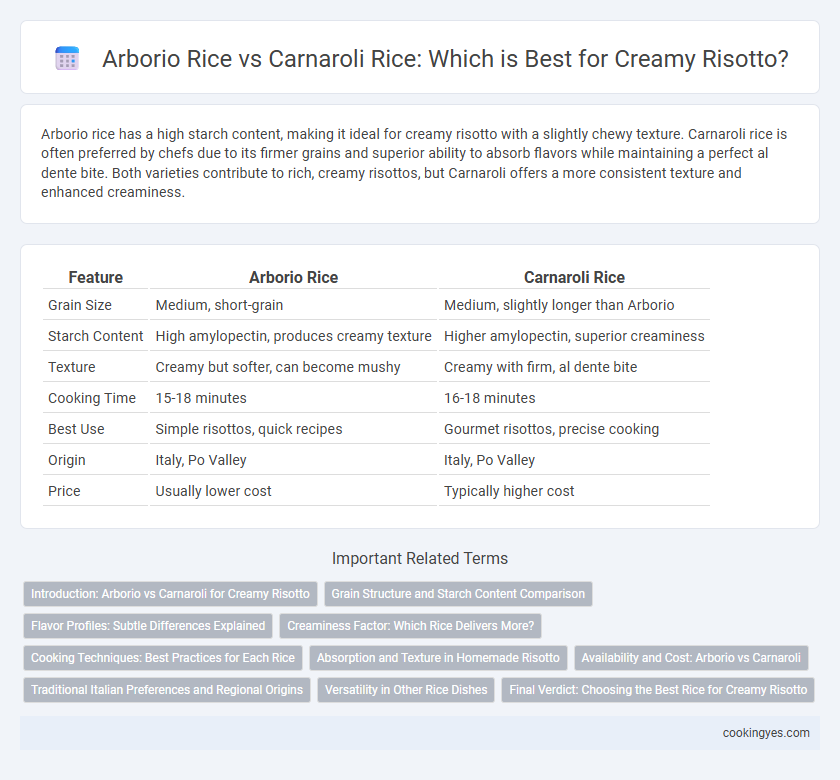Arborio rice has a high starch content, making it ideal for creamy risotto with a slightly chewy texture. Carnaroli rice is often preferred by chefs due to its firmer grains and superior ability to absorb flavors while maintaining a perfect al dente bite. Both varieties contribute to rich, creamy risottos, but Carnaroli offers a more consistent texture and enhanced creaminess.
Table of Comparison
| Feature | Arborio Rice | Carnaroli Rice |
|---|---|---|
| Grain Size | Medium, short-grain | Medium, slightly longer than Arborio |
| Starch Content | High amylopectin, produces creamy texture | Higher amylopectin, superior creaminess |
| Texture | Creamy but softer, can become mushy | Creamy with firm, al dente bite |
| Cooking Time | 15-18 minutes | 16-18 minutes |
| Best Use | Simple risottos, quick recipes | Gourmet risottos, precise cooking |
| Origin | Italy, Po Valley | Italy, Po Valley |
| Price | Usually lower cost | Typically higher cost |
Introduction: Arborio vs Carnaroli for Creamy Risotto
Arborio rice, known for its short, plump grains and high amylopectin content, delivers a creamy texture essential for traditional risotto. Carnaroli rice, often called the "king of risotto," boasts a firmer starch granule structure that provides superior absorption and a creamier, yet al dente result. Both varieties excel in creating rich risottos, but Carnaroli is preferred by chefs for its enhanced creaminess and ability to maintain texture during prolonged cooking.
Grain Structure and Starch Content Comparison
Arborio rice features short, plump grains with a high starch content that releases creamy texture ideal for risotto. Carnaroli rice has longer, firmer grains with an even higher starch level, providing superior creaminess and a more al dente bite. The grain structure and amylopectin concentration in Carnaroli make it preferred for consistent risotto viscosity and texture retention.
Flavor Profiles: Subtle Differences Explained
Arborio rice offers a slightly nutty and creamy flavor that enhances the richness of risotto, while Carnaroli rice provides a more delicate and buttery taste with a firmer texture. The higher starch content in Carnaroli results in a silkier, more velvety consistency without losing its shape during cooking. These subtle flavor differences make Carnaroli the preferred choice for chefs seeking a refined and balanced risotto experience.
Creaminess Factor: Which Rice Delivers More?
Arborio rice offers a high starch content that releases readily during cooking, producing a creamy, velvety texture ideal for risotto. Carnaroli rice has an even higher amylopectin level, enabling it to maintain firmness while delivering superior creaminess and a silkier mouthfeel. For chefs prioritizing a rich, creamy risotto, Carnaroli often surpasses Arborio in balancing creaminess with a slightly al dente bite.
Cooking Techniques: Best Practices for Each Rice
Arborio rice, known for its high starch content, requires frequent stirring and gradual addition of broth to release its creamy texture ideal for risotto. Carnaroli rice, often called the "caviar of rice," benefits from a gentler cooking approach with less stirring to maintain its firm, al dente center and rich creaminess. For best results, start both with a light toasting step and slow liquid absorption, adjusting heat to achieve the perfect balance of creaminess and bite.
Absorption and Texture in Homemade Risotto
Arborio rice absorbs liquid quickly, creating a creamy texture ideal for risotto with a slightly softer bite, while Carnaroli rice has higher starch content and firmer grains that retain shape better during slow cooking, producing a creamier yet al dente consistency. The superior absorption capacity of Carnaroli allows it to hold more broth without becoming mushy, making it preferred by chefs for homemade risotto with a perfect balance of creaminess and texture. Texture-wise, Arborio offers a tender finish, whereas Carnaroli provides a chewy, structured mouthfeel that enhances the risotto experience.
Availability and Cost: Arborio vs Carnaroli
Arborio rice is widely available in most supermarkets and tends to be more affordable than Carnaroli rice, making it a popular choice for budget-conscious cooks. Carnaroli rice, often referred to as the "king of risotto rice," is less commonly found and usually priced higher due to its superior texture and creaminess. Despite the higher cost, many chefs prefer Carnaroli for its ability to absorb liquids while maintaining firmness, justifying the expense for gourmet-quality risotto.
Traditional Italian Preferences and Regional Origins
Arborio rice, originating from the Po Valley in Italy, is the most commonly used variety for traditional risotto due to its high starch content and creamy texture. Carnaroli rice, often preferred by Italian chefs from Lombardy and Piedmont regions, is prized for its firmer grains and superior ability to absorb liquids, resulting in a more structured and luxurious risotto. Both varieties reflect regional culinary preferences, with Arborio favored for its widespread availability and Carnaroli celebrated in authentic Northern Italian recipes.
Versatility in Other Rice Dishes
Arborio rice is widely favored for its ability to absorb flavors and maintain a tender, creamy texture, making it ideal for risottos as well as rice puddings and thick soups. Carnaroli rice offers a firmer grain and superior starch content, which not only enhances creamy risottos but also holds up well in baked rice dishes and stuffed vegetable recipes. Both varieties demonstrate excellent versatility beyond risotto, with Carnaroli excelling in dishes requiring structural integrity and Arborio providing smoothness and richness in softer preparations.
Final Verdict: Choosing the Best Rice for Creamy Risotto
Arborio rice delivers a creamy texture with a slightly firmer bite, making it a classic choice for traditional risotto lovers. Carnaroli rice boasts higher starch content and better absorption, resulting in a creamier, silkier risotto with enhanced flavor retention. For the best creamy risotto, Carnaroli rice is often preferred by chefs seeking optimal texture and richness.
Arborio rice vs Carnaroli rice for creamy risotto Infographic

 cookingyes.com
cookingyes.com